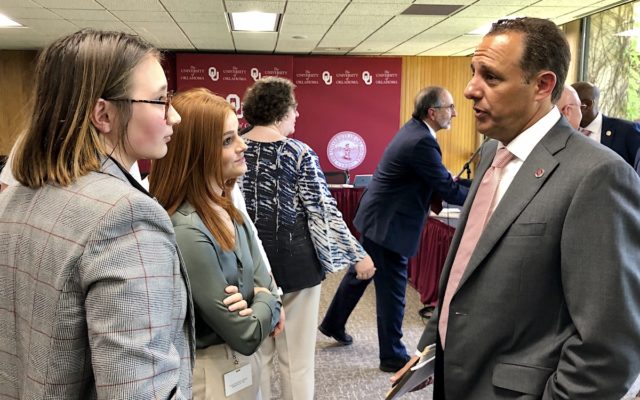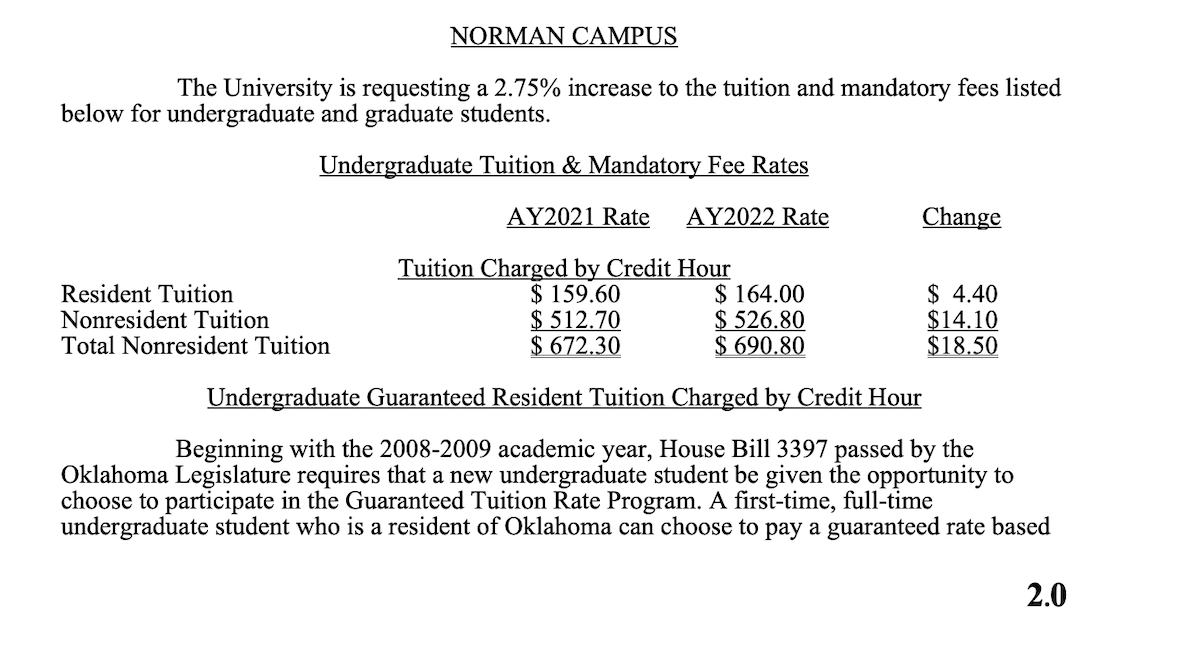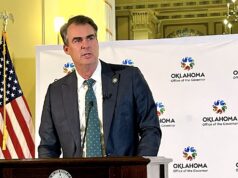
Despite the objections of two student leaders and a new regent, the University of Oklahoma Board of Regents today approved OU’s FY 2022 budget, increased a counseling fee for health students and advanced a 2.75 percent increase to mandatory tuition and fees at the Norman campus and the OU College of Law. If approved by the State Regents for Higher Education later this week, Tuesday’s votes will lead to the first tuition increase in four years.
Undergraduate Student Congress Chairman Crispin South and Vice Chairwoman Sidney May each questioned the “timing” of the tuition hike, which comes after three years of flat tuition, but also as the COVID-19 pandemic continues.
“This will, of course, make incoming students pay more,” South said. “For context, I just want to jump to the real life impact of what this is going to cost our students.”
South said the Norman tuition and mandatory fee increases will total $248 per year for in-state students, which he equated to “one month of food.” For out-of-state students, he said the increase would reach $671 per year.
“This is greater than a month of rent for our students,” he said.
May quoted the board’s ballyhooed strategic plan in making her argument.
“Have all of our other options been exhausted at this point?” she said, addressing Harroz. “In the strategic plan that was proposed under you, are you aware that increasing tuition may, at this time, not ‘focus on providing the highest quality education at the lowest possible cost and reducing student debt,’ and instead may achieve the opposite, which will [undermine] pillar four, by alienating marginalized groups from receiving a higher education.”
Following the students’ remarks, new OU regent Rick Nagel noted that he fought tuition increases when he was a member of the OU Student Government Association.
“I continue my fight now as a new regent,” Nagel said. “I am not for this budget because it has a tuition increase in it. I feel like students have, in good faith, been paying it forward for a few years.”
Nagel said the estimated $6.8 million that would be generated by the tuition and fee hikes could likely be found elsewhere in OU’s $1 billion budget.
“I do agree from a timing, affordability, transparency standpoint that now is not the time,” Nagel said. “I feel strongly that there were potentially other areas of the budget that could have been more closely examined.”
While Nagel’s remarks were well received by South and May, the board ultimately voted 5-1 to pass the three items in question.
“We haven’t had a tuition increase in 3 years. We’ve taken $65 million out of the budget,” Chairman Michael Cawley said. “A 2.75 percent increase is modest, to say the lease. We have to make investments (…) to make this university go forward.”
Regent Eric Stevenson said OU compares favorably among other universities when it comes to tuition and fees.
“Even after this increase, we are still going to be 75 percent of their cost. We are still going to be below market,” he said. “This cuts both ways, but everything the university has to deliver costs more. Food costs more, building materials cost more, electricity costs more.”
OU President Joe Harroz is trying to do more in terms of implementing the university’s strategic plan and positioning faculty and staff for more frequent pay raises.
“What do you do as you try to balance excellence and affordability?” Harroz asked rhetorically, reminding regents and the audience that regents and the administration of his longtime boss — former President David Boren — had raised tuition almost annually, while also increasing debt obligations. “The increases were well above inflation. They were in excess of that. We have data to back all this up.”
Harroz reminded those in attendance that when former President Jim Gallogly assumed the presidency after Boren, he revealed that OU “was operating at a loss, and the amount of debt it had taken on had increased,” something Harroz said 30 percent of universities in the country were also doing.
In March, regent Natalie Shirley told her peers that “OU’s budget is now balanced,” and she elaborated on a series of procedural and oversight changes.
“I don’t like any part of a recommendation that involves tuition increases,” Harroz said. “But we have to invest in things like our new development operation. We’ve identified our No. 1 priority as need-based scholarships. (…) There has to be a regular program of salary increases (for faculty and staff) to address the impact of inflation as you go through that. Truly great universities invest in graduate students in ways we have not been able to do.”
While committing that he will engage more directly with students on the topic of tuition in the future, Harroz emphasized that the university “is better” than it used to be.
“The state of this university is really good,” he said.
OU Health integration approved
Tuition and fees were not the only items that drew public comment Tuesday, with the effort to launch a controversial and complicated hospital and physician practice group merger by July 1 drawing criticism from some staff.
“I’m a rank and file faculty member,” said Dr. Kate Morris, a cancer researcher who also teaches at the OU College of Medicine. “To have a go-live date of July 1 when there were so many details to iron out (…) we have lost staff over this merger, and we cannot care for our patients alone.”
In short, the state-run OU Physicians group is merging with the nonprofit OU Medicine, Inc. to create a new nonprofit, comprehensive and academic health system called OU Health.
“This is a historic moment,” Harroz said. “Twenty-six years ago, the University of Oklahoma and the [Oklahoma Hospitals and Authority Trust], like so many other academic hospitals in the country, were about to go bankrupt. To survive, the hospitals were sold in a transaction to Columbia HCA. That went on for a very long time. The problem is, while it survived, you cannot flourish if your hospital is separate from the physicians themselves and the clinics you run.
“If you’re not together, neither one is going to prosper.”
But in the three months since OU leaders announced the effort, some employees have grown frustrated with the process, which has featured numerous questions about retirement benefits, drug testing and the need for some people to reapply for their jobs.
“I respectfully ask that we pause [and] implement this the right way, albeit it slower but with more consensus,” Morris said. “I think we have the raw materials, but I don’t want to rush the cooking process and spoil them.”
Harroz asked to move ahead with the July 1 date, with the caveat that employment shifts will be delayed until lingering questions are answered.
“This is not a comfortable thing to do. There is a lot of change to go in, and it is years in the making,” Harroz said. “It’s terribly complicated, but it also terribly simple.”
With Frank Keating not attending Tuesday’s meeting, regents voted unanimously 6-0 to grant Harroz and his team the authority to finalize the OU Health integration.
Cawley praised the extensive work put into the project already.
“One thing that impressed me in all of this is, around this nation of all these integrations that have happened, not one has said they want to go back,” Cawley said.
From the audience, Morris told her colleagues: “That’s actually not true.”

Other OU Health merger details approved
For each university employee who transfers employment to either the existing OU Medicine Inc. or the new OU Health Partners Inc., regents also approved transferring “the entire balance of paid time off (PTO)” to the respective organization.
Harroz said about 1,400 employees will be transitioning from OU to the nonprofit entities. Tuesday’s agenda elaborated on the PTO issue, which does not include extended sick leave (ESL) or PTO for faculty or retiring employees:
As part of the integration, the full-time employment of some staff will transition from the University to OUMI or OUHPI. Current University policy provides that employees may receive a maximum accrual of 336 hours of PTO before earned hours automatically begin accruing to an individualized ESL bank. Ordinarily, a terminating employee receives the cash value of PTO hours up to the “annual accrual rate” on a final University paycheck as long as the employee is in good standing. The “annual accrual rate” under University policy is determined by years of service or position, but it is in every case lower than the “maximum accrual rate” of 336 hours for all employees. In order to ensure transferring employees receive the actual vacation hours they have accrued at the University and to preserve their ability to take time off in the future, all PTO accrued at the time of transfer will be carried forward to OUMI or OUHPI and paid in accordance with the applicable organization’s policies.
Regents also amended the eligibility requirements of the OU Dependent Child Tuition Waiver program to include those dually employed by OU and OU Health. Tuesday’s agenda explained the action item:
In order to avoid this unintended consequence of the integration and the dual employment structure, and subject to the program’s continued compliance with the requirements of Internal Revenue Code Section 117, the university desires to amend the Program to extend eligibility thereunder to all faculty members who are dually-employed by OU and OUHP regardless of whether the faculty member is in a benefits eligible position and appointed at .75 full-time equivalent (FTE), and without requiring that the faculty member or his/her dependent child be enrolled in or added to the OU employee medical insurance plan.
Other tuition increase notes

At the OU Health Sciences Center campus, the student fee for counseling services will increase from $24 to $40 for a spring or fall semester, the first time the fee has been increased since its 2013 implementation.
Governed by a separate board of regents, Oklahoma State University is raising its mandatory tuition and fees by 2.5 percent.
OU’s board also oversees Rogers State University and Cameron University. While Cameron University’s tuition and mandatory fees will stay flat next year, Rogers State University requested and received approval for an increase.





















